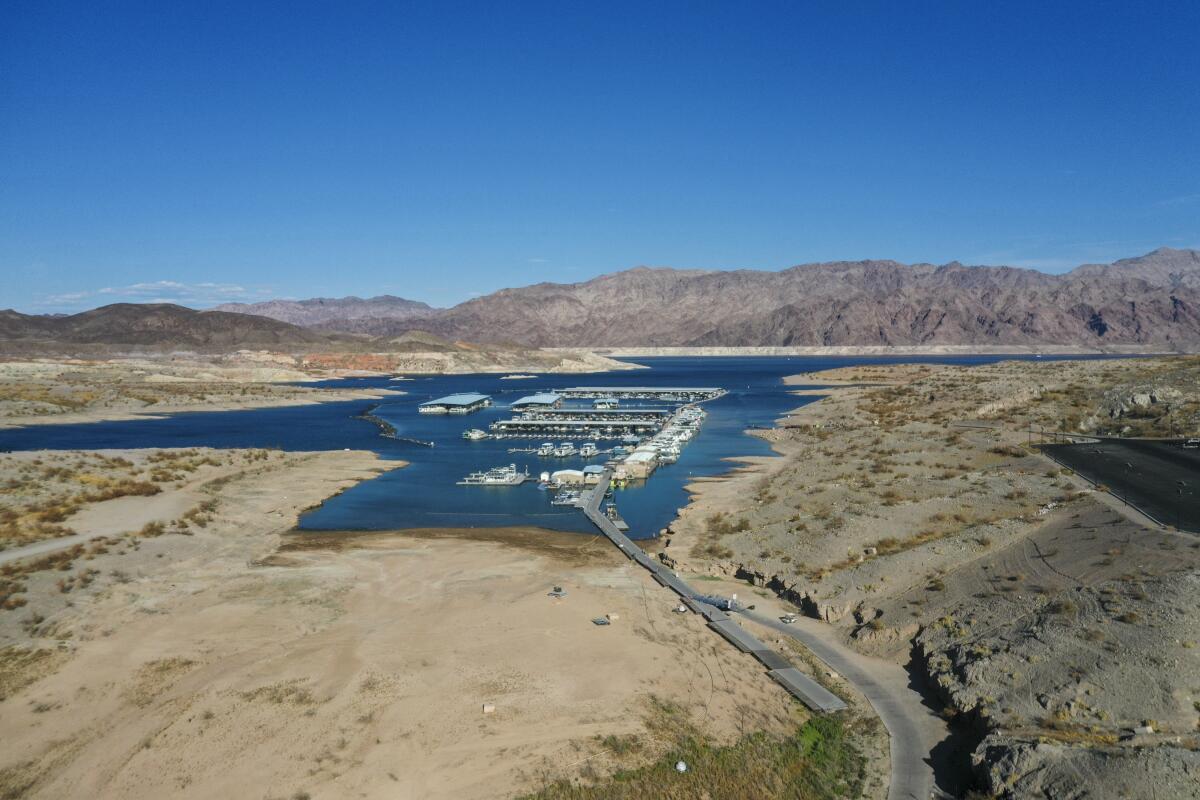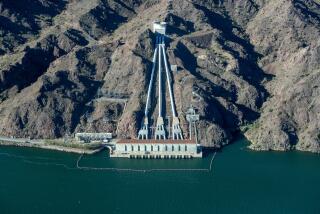California, Arizona and Nevada agree to take less water from ailing Colorado River

Trying to stave off dangerously low levels of water in Lake Mead, officials in California, Arizona and Nevada have reached an agreement to significantly reduce the amount they take from the Colorado River.
The problem took on new urgency this summer when the federal government declared a first-ever water shortage in the 86-year-old reservoir near Las Vegas.
The agreement, which was signed Wednesday after four months of negotiations, aims to keep an extra 1 million acre-feet of water in the lake over the next two years. Water agencies in Southern California, Arizona and Nevada agreed to find water savings from various sources and split the $200-million cost with the federal government.
The Colorado River has been chronically overused, and its flows have shrunk dramatically over the last 22 years during a “megadrought” that research shows has been worsened by global warming.
If the lake continues to drop, the Southwest could have no choice but to make deeper cuts.
“We’re experiencing what scientists are calling the new normal, a warmer, drier West,” Camille Calimlim Touton, commissioner of the federal Bureau of Reclamation, said Wednesday during a speech that was livestreamed to the annual conference of the Colorado River Water Users Assn. in Las Vegas. “The basin is at a tipping point.”
The Colorado River provides water for about 40 million people and farmlands from Wyoming to the U.S.-Mexico border.
Snowmelt runoff forms the river’s headwaters. Touton noted that last winter, the amount of snow that fell in the Rocky Mountains was nearly average.
“But due to warm temperatures, dry soil conditions and uptake of soil moisture into plants, we only saw 32% of average runoff,” she said. “That is a staggering difference.”
The latest federal projections, she said, show the “grim reality” of continuing water level declines in Lake Mead and Lake Powell, the two largest reservoirs on the river.
She pointed to daunting “hydrologic deficits across the board” going into this winter. The first snowfalls in parts of the Rockies this year were among the latest on record.
Discussions about how to adapt to a river with less water dominated the Las Vegas conference, where representatives of the seven states that depend on the Colorado met with counterparts from Native tribes and the U.S. and Mexican governments.
The new deal, called the 500+ Plan, nearly doubles the water reductions that the three states — which make up the lower basin of the river — negotiated in 2019 under what is called the drought contingency plan.
Since that time, the water woes on the Colorado River have gotten only worse as extremely hot, dry conditions have baked the watershed, dramatically reducing flows. Lake Mead, which was close to full in 2000 and at 41% of capacity when the 2019 deal was signed, is now at 34%.
The lake’s growing “bathtub ring,” formed by mineral deposits, marks the rocky desert slopes about 160 feet above the retreating shoreline.
The deal is designed to leave an additional 500,000 acre-feet of water in the reservoir next year, and the same amount again in 2023. For comparison, California, Arizona and Nevada used 6.8 million acre-feet of Colorado River water last year.
The plan calls for the bulk of water savings to come from Arizona and California.
Some of the reduction will come through payments for water conservation in farming areas, including those to growers who leave portions of their lands dry. Tribes have agreed to leave water in Lake Mead in exchange for payments. And some water districts will also take less from the reservoir.
Water agencies in Arizona have agreed to pay about $60 million over two years to fund the effort. The Metropolitan Water District of Southern California and the Southern Nevada Water Authority have each agreed to contribute $20 million. The federal government is expected to pay $100 million.
Water managers said the agreement came together quickly because the situation has become so dire. But experts said much more still needs to be done — especially to address climate change and prepare for its worsening effects.
“The 500+ Plan is adaptation. But what we’re seeing coming down the line is that the hydrology gets worse and worse,” said Michael Cohen, a researcher at the Pacific Institute, an Oakland-based water think tank. “And what the water managers need to do is go to their governors and their delegations and say, ‘Climate change is a train wreck for the West.’ Unless we wrap our arms around this ... rein it in, we can never adapt.”
He said climate projections show that as humanity continues to pour more carbon into the atmosphere, the river will continue to dry up.
“It’s an existential threat to Western life,” Cohen said, adding that water management officials are “dancing around it” without “taking the big step of saying, ‘We need to prioritize water over carbon.’”
Officials have yet to begin negotiating new rules for dealing with shortages after 2026, when the current rules are set to expire.
The law that governs the river and divides its flows were established nearly a century ago starting with the 1922 Colorado River Compact. That and subsequent agreements left the Colorado over-allocated. So much water has been diverted for decades that the river’s delta in Mexico has been largely transformed into a dry riverbed that winds through farmlands and desert.
The hotter, drier climate in recent years has worsened the mismatch between supply and demand for water resources.
“There’s way more legal entitlements to water than there is water,” said John Entsminger, the general manager of the Southern Nevada Water Authority.
Entsminger, who is the also president of the Colorado River Water Users Assn., said the latest deal is the “next increment” in adapting water use to the limits of the available supplies. He said authorities are “negotiating to try to fit a shrinking river into a new paradigm that takes care of 40 million people.”
The declining water levels have also been reducing the amount of power generated at Hoover Dam and Glen Canyon Dam, a problem that Touton said will get worse if dry conditions persist.
Meanwhile, environmentalists said the upper basin states — Colorado, Utah, Wyoming and New Mexico — also urgently need to take steps to use less water from the river.
The environmental group Utah Rivers Council said in a report this week that its analysis showed that Colorado, Utah and New Mexico are overusing water supplies.
The authors of the report estimated the current water deficit in the upper basin at 500,000 acre-feet per year. They called for a halt to new water diversions in the upper basin, such as Utah’s plan to build the Lake Powell Pipeline, which would carry water to growing cities.
“It’s really time for the upper basin to get serious and stop proposing these new water diversions,” said Zachary Frankel, group’s executive director. “The only thing we see are new proposed uses, meaning as our income stream is declining in the Colorado River, what our household leaders in the upper basin are doing is proposing more spending, which is extremely irresponsible.”
Tribes have historically been left out of Colorado River negotiations among the states, even though they hold rights to about 20% of the water. Some have secured settlements specifying their water rights, while others are still seeking to settle their claims.
In the 2019 deal, two tribal nations — the Gila River Indian Community and the Colorado River Indian Tribes — contributed water that helped make Arizona’s piece of the agreement work. But the signatories of the deal, which was sealed in a ceremony on a terrace overlooking Hoover Dam, were the seven states and the federal government.
This time, leaders of the two tribes joined Tanya Trujillo, the Interior Department’s assistant secretary for water and science, in signing a related set of water agreements.
“Tribes are a vital part of this process,” said Gov. Stephen Roe Lewis of the Gila River Indian Community. “Tribes shouldering this sacred responsibility, this leadership, can and will help shape the future of the Colorado River.”
Timothy Williams, chairman of Fort Mojave Indian Tribe, said he hopes that tribes will play a central role in the talks on the post-2026 rules.
He said he hopes that when the next big agreement comes out, “you’ll see tribes up there on the Hoover Dam.”
More to Read
Start your day right
Sign up for Essential California for news, features and recommendations from the L.A. Times and beyond in your inbox six days a week.
You may occasionally receive promotional content from the Los Angeles Times.








